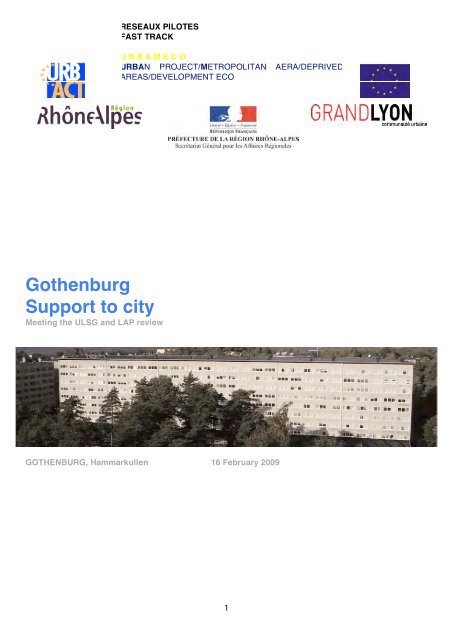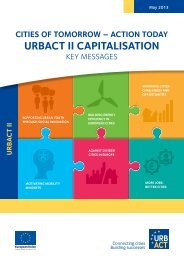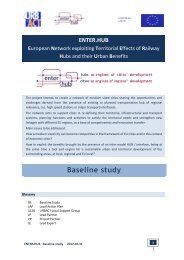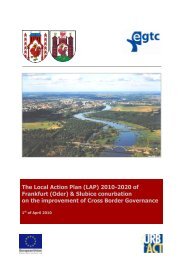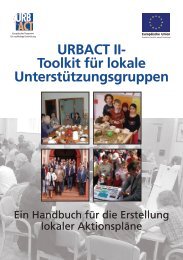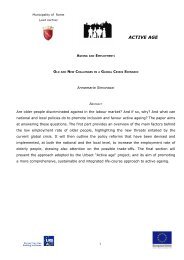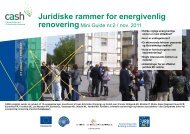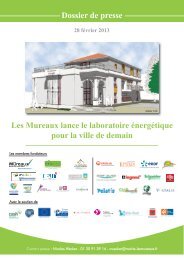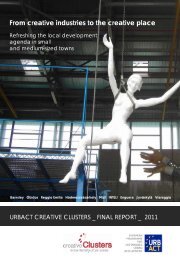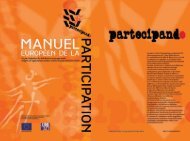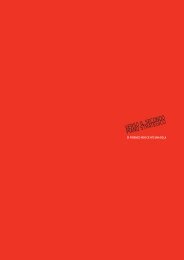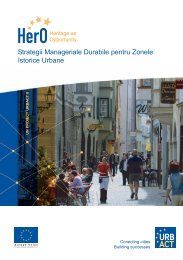Report Goteborg - Urbact
Report Goteborg - Urbact
Report Goteborg - Urbact
Create successful ePaper yourself
Turn your PDF publications into a flip-book with our unique Google optimized e-Paper software.
RESEAUX PILOTES<br />
FAST TRACK<br />
U R B A M E C O<br />
URBAN PROJECT/METROPOLITAN AERA/DEPRIVED<br />
AREAS/DEVELOPMENT ECO<br />
Gothenburg<br />
Support to city<br />
Meeting the ULSG and LAP review<br />
GOTHENBURG, Hammarkullen 16 February 2009<br />
1
INTRODUCTION<br />
Intake visit: support to cities p.3<br />
Purpose of the visit to Hammarkullen p.4<br />
The city requests for the intake visit p. 4<br />
1. INPUT p.5<br />
1.1 Academic research and community work: the experience of the Comuniversity p.5<br />
1.2 Design studio at the Master program Design for Sustainable Development. p.8<br />
2. EXCHANGE p.10<br />
2.1 Towards the LAP p.10<br />
2.2 LAP &ULSG. Actual stage. p.12<br />
2.3 Meeting Gothenburg ULSG for Hammarkullen p.13<br />
4. RECOMMENDATION p.17<br />
2
INTRODUCTION<br />
Intake visit: support to cities<br />
The URBAMECO programme is structured around three types of exchange formats<br />
whose scope is to maximize the capacity of learning and exchanging of knowledge<br />
among the partner cities and Managing Authority. The format chosen by this network<br />
consists of a)meetings in form of thematic sessions, b)101 cities exchange and c)<br />
individual support to cities.<br />
The latter is specifically dedicated to the cities which request specific support by the<br />
expertise offered by the Lead expert and Thematic expert of URBAMECO.<br />
As for initial agreement, each city in the network is committed in developing its own<br />
Local Action Plan as final output of its participation in the programme. The<br />
methodology to achieve the drafting of the LAP includes the creation of a Local<br />
Support Group ( or the implementation of pre-existing participatory structures) which<br />
gathers local key stakeholders in the city. The participants to the ULSG are selected<br />
at the discretion of the municipality, which is responsible for the drafting of the LAP.<br />
The ULSG should include a wide variety of actors directly and indirectly relevant to<br />
the topic of local economic development and integrated approach in deprived urban<br />
areas as chosen by URBAMECO.<br />
In the case of URBAMECO, under the guidelines set by the Lead Partner city of<br />
Grand Lyon, the support for cities is a specific workshop which sees the presence of<br />
the Lead expert or/and thematic expert closely working with one partner city on<br />
demand issues. The request for this kind of collaboration comes from the partner<br />
city, which is willing to have guidance for instance, in the structure of the ULSG, its<br />
facilitation and promotion, as well as in the drafting of the LAP , or in overcoming<br />
specific barriers or issues encountered in the lifetime of the programme.<br />
The support to city is figured out as a local workshop led to a definition of and a<br />
response to main challenges faced by the member cities and regions as well as to<br />
highlight key topics regarding the draftiing of LAP. The local workshop is usually<br />
housed at the Municipality office, or at the meeting place of the ULSG. This allows to<br />
have the chance to meet direclty some of the stakeholder in the city, participating in<br />
the ULSG, visit the target area and understand more in depth the advancement of<br />
the project.<br />
The guidance provided is based on two main documents the framework of<br />
URBAMECO appraoch established at the beginning of the network (cf. summary at<br />
the first chapter of <strong>Report</strong> Costanta september 2008) and the scheme for the LAP<br />
provided to the cities. The toolkit for LSG provided by the sercreatariat, in the case of<br />
URBAMECO has been used as reference document to analyse what was already<br />
practiced by the cities. Due to the interruption of activities in PHASE II, it has been<br />
realtively possible to influence the structure and the work of ULSG in an advanced<br />
stage.<br />
In the case of URBAMECO 5 partner cities out of 9 benefitted of this kind of intake<br />
visit.<br />
The support to cities covered the following tasks:<br />
• Additional assistance for the organization of the URBAMECO partnercity and<br />
Managing authorities meeting<br />
3
• Assessment of the actual urban and regional strategy and possible<br />
hindrances in the implementation on the LAP<br />
• feedback on the draft of the LAP 1<br />
• facilitation tools and experiences in managing a meeting of the local support<br />
group<br />
• whenever possible coincide the intake visit with the meeting of the ULSG<br />
Purpose of the visit to Hammarkullen<br />
The main purpose of the “Support to City” within URBAMECO for the case of<br />
Gothenburg has been to analyse the advancements of the LAP and, to give<br />
recommendations for its possible improvement and strategic advice for the<br />
realisation of its aims.<br />
In addition, a meeting with the Local Support Group of Hammarkullen have been<br />
scheduled in order to update each other with the advancement of the action to be<br />
undertaken for the successful implementation of the LAP. In this framework have<br />
been checked the feasibility of the actions in relation to the funding opportunies<br />
offered by the regionʼs Operational Programme as well as from other sources of<br />
funding for integrated urban development projects.<br />
It is the main purpose of this <strong>Report</strong> to report the kind of input collected from the<br />
meeting of different stakeholders and to summarize the contribution for the<br />
advancement of the LAP.<br />
In particular, this report:<br />
• Collects input from the initiatives happening in the area of Hammarkullen<br />
such as the cooperation with the University, the activities of the Local NGOs,<br />
th plan for the regeneration of the area and the Vision angered project<br />
• Provides the summary of the strategic recommendations for the advancement<br />
of the LAP mentioning the next steps to be undertaken towards the drafting of<br />
the final plan.<br />
• Makes proposals for ULSG and for the possible involvement of additional<br />
stakeholders to keep the sustainability of the participatory process.<br />
The city requests for the intake visit<br />
The city of Hammarkullen has organized a strong architecture of ULSG and defined<br />
the strategy as summarized in the previous chapter. Currently, the role and<br />
responsibilities for the implementation of the LAP objectives have been established,<br />
but the procedure for approval by all relevant authorities is ongoing. Moreover,<br />
politically there is still a major effort to be achieved in order to have on board relevant<br />
actors dealing with e.g. public transportation, supply chain, with a strong involvement<br />
of the chamber of commerce.<br />
In practical terms the intake site visit was requested:<br />
• To check out the actual stage of ULSG and LAP in one day meeting, which<br />
dedicated the morning to the workshop with the member of the steering ULSG<br />
1<br />
Beside the support to cities, all the partner cities received specific support and feedback for the LAP.<br />
4
committee and the afternoon to revising the LAP draft together with the<br />
members of the Local Action Team Eeva Bolin and Ulrika Evenas. A more<br />
informal meeting in the afternoon with Susan Runsten representative of the<br />
Municiplity of Gothenburg city referent for URBAMECO.<br />
• To meet the participants and to present the approach of URBAMECO network<br />
by URBACT-expert Laura Colini. Since most of the participants to the ULSG<br />
group never had the chance to take part to any official meeting of<br />
URBAMECO, the Local Action Team steering the work of the Lap, suggested<br />
that it could be beneficial to have direct voice from the network at one of the<br />
ULSG meeting.<br />
• To listen to dialogues among the ULSG participants and eventually provide<br />
feedback to the methodology employed.<br />
• Support with the development of a strategy for filling the gaps or overcome<br />
the barriers met in the course of the process.<br />
1. INPUT<br />
The intake visit which was dedicated to the above mentioned requests, allowed to<br />
gather additional inputs and information regarding the activities and plans. Two<br />
particular focuses regard the connection between the university and community of<br />
Hammrkullen with the project comuniversity, with the department of Social Studies,<br />
University of Gothenburg and other initiaves that involved architecture students in<br />
studing the possible design of Hamarkullen main square.<br />
The latter initiative, although is starting in autumn 2009 and It is not an action directly<br />
connected to the LAP, but it is a sign of a growing interest for the new area, and it is<br />
a unique opportunity for engaging architecture students in a creative design of the<br />
core of this neighbourhood with the participation of the citizens.<br />
1.1 ACADEMIC RESEARCH and COMMUNITY WORK: the experience of<br />
HAMMARKULLEN<br />
A networking university in Hammarkullen, orientated towards contemporary<br />
events and rooted in the community<br />
Lasse Fryk is an academic who has been engaged for a long time in the idea of<br />
bringing the school to the neighborhood and viceversa, in order to enhance tha<br />
capacity of enhancing situated knowledge and more qualitative research approach.<br />
LAsse Fryck is a participant to the ULSG for Hammarkullen and a spokeperson for<br />
the Comuniversity project included in the LAP.<br />
What follows is a text drafted in Gothenburg, 25 November 2008 by Lasse Fryk and Bosse<br />
Forsén, Assistant Professors, regarding the Comuniversity which is presented as strategic<br />
input to the LAP.<br />
5
The Comuniversity – a collaborative project between the Lärjedalen district council (SDN) and<br />
the University of Gothenburg – currently has its base in Hammarkullen. It began, historically,<br />
as early as 1989, when some parts of the degree programme in social work were relocated<br />
into the field, in Lärjedalen. This collaboration has been extended over the years, with more<br />
and more aspects of the programme being held in Lärjedalen. The reciprocal exchanges<br />
between the two parties has gradually intensified and deepened. Since 2003 Lärjedalen is the<br />
home to a field-based teacher-training programme as well. This programme variant, unique in<br />
Sweden (teacher training with a specialization in community pedagogy) has developed under<br />
the aegis of the Comuniversity. The municipality has put facilities at our disposal and provided<br />
some financing, and has facilitated a twenty-year period of joint development work in the<br />
public sector in Lärjedalen, which has expanded hand in hand with the undergraduate<br />
programmes described above.<br />
Below, we describe the ideas and experience gained within the framework of the field-based<br />
social work and teacher training programmes at the Comuniversity.<br />
What has twenty years in Lärjedalen given us?<br />
In a society characterized by accelerating change and increasing diversity, many aspects of<br />
traditional university education appear too classroom-bound, too structured, and too sluggish<br />
to be constructive, creative and flexible in the face of the challenges the social workers and<br />
teachers of today and tomorrow, as well as university teachers, have to grapple with. The<br />
experience we and others have gleaned from our field-based alternative is unequivocally very<br />
positive. Students, internal and external assessors, and our users all state loud and clear that<br />
the road map we are following is an extremely fruitful and enriching one for all parties<br />
concerned.<br />
Bringing separates together is one of our lodestars. Concretely, this has meant moving<br />
from rooms to interstices, entering into mutually rewarding exchanges with the institutions in<br />
the real world for which our students' educations are preparing them, and with the citizens for<br />
whom these institutions are run. In preparation for future professional cooperation between<br />
schools and the social services, students from the two programmes are brought together to<br />
carry out joint, concrete projects in the field in Lärjedalen. This collaboration also enriches<br />
both groups of students in anticipation of their professional roles. . Seeing the degree<br />
programme as practical work experience is another motto that guides our work, and can<br />
be described as bringing together theory and practice, ideas and action. We see it as valuable<br />
for students, during their educational programmes, to use the ideas that are cornerstones of<br />
the professions we are training them for. The active participation of all parties involved is a<br />
key to being able to establish, together, the necessary diversity to be able to operate with a<br />
wide repertoire of tools in a multifaceted world.<br />
Our exchanges between the district and the university as a whole and, today, mainly between<br />
Hammarkullen and the teacher training and social work programmes in the field, have a clear<br />
win-win profile, For us, the district provides a broad arena for essential learning and for<br />
enhancing our competence, at the same time as we can contribute concretely to community<br />
development, by carrying out our own projects and fulfilling commissions from our<br />
counterparts. The district, in turn, gains access to a wide range of potential resources,<br />
primarily because the students participate actively in community activities in work done in the<br />
public sector. Thus existing activities in the public sector get new input from Others, and new<br />
6
activities can be established simply because there is strength in numbers, and more<br />
contributions means greater diversity.<br />
The concrete objective of these educational programmes is to contribute to socially<br />
sustainable development – for the individual (the citizen, student, professional worker, etc),<br />
for the group/work team, for the organization/institution of which one is a part and,<br />
whenever possible, for the community.<br />
In a community like Hammarkullen, social development places high demands on the active,<br />
democratic participation of individuals and groups in shaping and being shaped, on<br />
competence, and in terms of being able to face new, unpredictable developments<br />
constructively and creatively, and in terms of lifelong and life-wide socially sustainable<br />
individual and collective learning. We consider our activities, together with those of all the<br />
other parties who share in our overarching ideas, as a potentially hopeful contribution to<br />
making the future more meaningful for all involved. We see ourselves as a spoke in a larger<br />
community-based wheel. To our intense satisfaction we also see more and more parties<br />
joining our cooperative endeavour, working together with us on the development of a fieldbased<br />
Comuniversity.<br />
Within the Academy, interest in activities rooted in the community is growing<br />
Beyond the activities described above, a large number of research projects have been<br />
conducted in the district (not least by Professor Ove Sernhede). Other individuals and groups<br />
have also participated actively in recent years in concrete activities, as part of various working<br />
groups in the district (Chalmers University of Technology, Department of Architecture,<br />
University of Gothenburg, Department of Conservation, which has an international Master<br />
level programme) or expressed their interest in collaboration in the district (Gothenburg<br />
University: Centre for cultural studies, Academy of Music and Drama, School of Design and<br />
Applied Arts, Museum of World Culture, Museion, and others).<br />
On the Hammarkullen side, there are also a large number of committed parties associated<br />
with the public sector, the housing companies, various local associations, etc. There are<br />
available office facilities at the central square, Hammarkulletorget, on the same premises as<br />
the citizens' information office, the library, the culture centre, the Angered Folk High School,<br />
and the open unit for social services and social pedagogy. There is tremendous potential in<br />
terms of resources that could be developed through further cooperation among the various<br />
parties already involved and between them and the community as a whole. Greater<br />
collaboration reinforces the point of departure for:<br />
- contributing to active development of exercising citizenship,<br />
- developing constructive, creative learning environments,<br />
- strengthening social and pedagogical entrepreneurship,<br />
- participating actively in the construction of society,<br />
- formulating one's own actions conceptually and in words.<br />
With the active presence and commitment of students, teachers, and researchers in these<br />
developmental efforts, it is also natural to document the growth of knowledge in various ways.<br />
An evaluation concerning the quality of the degree programme in social work in<br />
Lärjedalen carried out within the framework of The education Institute at Gothenburg<br />
7
university. The authors are Kajsa Ohrllander at the university of teaching in<br />
Stockholm and Kerstin Borhage working at the Swedish Government department for<br />
education.<br />
<strong>Report</strong> in Swedish language<br />
http://www.ufl.gu.se/digitalAssets/1148/1148666_Rapport200703.pdf<br />
1.2 DESIGN STUDIO at the Master program Design for Sustainable Development.<br />
In winter 2008-2009 a class of the Master program Sustainable Development Project Suburbs<br />
Design and Future Challenge dedicated a series of design practices to Hammarullen in<br />
collaboration with the Folketshuis and some of the local citizens. Participatory planning events<br />
using techniques as planning for real, street events et al. worked as guidelines for the<br />
students planning practices.<br />
For further information check the online presentation of the classʼs outcomes.<br />
The success of the initiative, created a second call for a winter semester seminar on<br />
Hammarkullen for the master students in design for sustainable development. The call is<br />
reported here, as this initiative may constitute a valuable future resources in the involvement<br />
of students design for the plaza, in relation to the objectives defined by the LAP including the<br />
re-design of Market place, the creation of University campus, and dynamization of the House<br />
of People as meeting center in the main plaza as.<br />
SUBURBS<br />
Chalmers Architecture, Master program Sustainable Development<br />
Project Suburbs Design<br />
and future challenges<br />
Byggnadsvård och restaurering 20082009<br />
Architectural Conservation 20082009<br />
Master Programme in Design for Sustainable Development (MPDSD)<br />
http://www.student.chalmers.se/sp/program?program_id=605<br />
Design & future challenges in Hammarkullen<br />
is a design studio in the Master program Design for Sustainable Development. It<br />
takes place in Hammarkullen. This design studio introduces the social dimensions of the<br />
vision, focusing the specific conditions in mass‐housing suburbs of the 60s and 70s. Public<br />
participation of<br />
citizens is a central aspect, tools and methods for design and planning in collaboration with<br />
citizens and other local stakeholders are used.<br />
8
Aim<br />
The studio will give knowledge about the significance of the social dimension of<br />
sustainable development and focusing urban development in suburban areas built in<br />
the 1960s and 70s as part of the Swedish million programme.<br />
Learning outcome<br />
At the end of this studio the students will be prepared to work as professional<br />
architects,<br />
planners, designers, engineers, etcetera, in design, planning and reconstruction of<br />
suburban areas from the million programme – linking social aspects to e.g.<br />
environmental, technical, aesthetic, economic aspects of sustainable development<br />
Equivalent learning objectives relate to<br />
– the physical environment<br />
is the construction of the million programme, i.e. the political background as well as<br />
the actual physical planning and aesthetics results in form of infrastructure,<br />
landscape design, building design, building construction and building materials.<br />
– the social environment<br />
is the people living in the suburb and the people working there or being active in<br />
other ways. Concepts in the field of sociology e.g. urbanization, globalization,<br />
governance, social exclusion, ethnicity, culture studies, segregation, security, safety;<br />
– participative tools and methods<br />
for design and planning in collaboration with citizens, employees and other local<br />
actors<br />
– linking social aspects to other aspects<br />
to e.g. environmental, technical, aesthetic, economic aspects of sustainable<br />
development<br />
9
2. EXCHANGE<br />
2.1 Towards the LAP<br />
The neighbourhood of Hammarkullen is located in a suburban area at the north part<br />
of the city , 20 min away by Gothenborg center. Hammarkullen is part of the<br />
Lärjedalen city district included in the larger district of Angered. Hammarkullen is not<br />
one of the prioritized neighbourhood for the strategic plan and the Local Development<br />
agreement of Gothenburg, but in order to support the integrated development of this<br />
neighbourhood the City of Gotheborg has chosen Hammarkullen as target area for<br />
Urbameco project. The neighbourhood once built as social response to lack of<br />
housing in the 60ies and 70ies, became in the one of the symbol of urban decay.<br />
10
Hammarkullen as pictured by Jens Jenssen in the seventies<br />
Possible potentials existing in the areas have been underestimated and the work of<br />
the social workers , association of citizens, housing associations, NGos active in the<br />
area offer a picture much more promising than one may imagine at first sight. The<br />
livelihood of the services provided in the area in terms of cultural events, festivals,<br />
health support and many others are a valuable and unique resource of this<br />
neighbourhood.<br />
In March 2007, was held a Future Workshop dealing with new perspectives for the<br />
area with participants who live or work in the area. In parallel a Local Forum for<br />
Health and Crime Prevention with about 20 members from different authorities deals<br />
with crime prevention and safety in the area.<br />
The participants in the Workshop defined problems in their area and tried to find out<br />
how these problems could be inter-related. They were also asked to formulate<br />
visions for the neighbourhoodʼs future and in particular for central shopping area and<br />
main square - the market place Hammarkulletorget – and to think about ways to<br />
reach their objectives 2 .<br />
It is from the results of this workshop that the ULSG group for URBAMECO LAP<br />
based its first roots, welcoming in the course of time the active voices of the<br />
neighbourhood, while engaging different stakeholders active a city wide and regional<br />
level.<br />
As result of the activities of the ULSG the strategy developed for Hammarkullen<br />
focused on strengthening the position of this neighborhood in the city region through<br />
economic growth, development of the market areas towards an integrated<br />
development of Hammarkullen.<br />
2<br />
Cf. the baseline study 2008<br />
11
2.2 LAP & ULSG. ACTUAL STAGE<br />
At the time of the intake visit the ULSG defined the aims of the LAP around 4 main<br />
objectives:<br />
New centre for Hammarkullen<br />
1. REAL estate owner and market place<br />
Market area: renovation and redesign the market area: involvement of local shop<br />
keepers<br />
Low energy consumption and environmental measures; Study for elements of<br />
ecological modernization of housing<br />
Organize a design competition for the new shopping area: involving the students of the<br />
local university (cf Power point of the initial experience)<br />
Make an architectural plan to refurbish the market building in the main square. Part of<br />
it should be used as shops and office space while adapting the architecture to<br />
welcome social and cultural activities. Organize co-financing for such reconstructions<br />
and realize the next retail and office space for Hammarkullen<br />
Get the company that is responsible for underground line, the one that owns the<br />
building with the shops above the underground station as well as the shopkeepers,<br />
involve the LSG<br />
Central Square. Organize community-based planning process (according to the<br />
participatory methods of different target groups [children, young people, elderly people,<br />
women, etc.) towards public design with workshops for the central square including all<br />
newly designed buildings, spaces, signs and furniture in public space etc.<br />
2. FOLKETS HUS AS: THE LIVING HEART OF HAMMARKULLEN<br />
Modernization of the Folkets Hus organizing a process with all users,<br />
including elderly people for a relocation of their activities;<br />
Make an architectural planning for reuse parts as shops and office space as<br />
part of the new market area, while adapting the architecture to welcome<br />
social and cultural activities in the building; Organize co-financing for such<br />
reconstruction and realize the next retail and office space for<br />
Hammarkullen.<br />
3. UNIVERSITY CAMPUS. Integrating the planning for this proposal into the<br />
above described processes of a new functional planning for the<br />
FolketsHus and with the current planning for new housing<br />
Hammarkullen–including student accommodations. Negotiation with the<br />
company that owns most of the social housing.<br />
Multiethnic second chance schools “where the worlds meet”<br />
4. Hammarkullen - the centre of education<br />
The Ulsg is structured with a steering group that includes stakeholders at local, urban<br />
and regional level, and 4 thematic groups who are open to local citizens organized in<br />
associations, commimttee, or group of interest for specific initiaves relevant to one or<br />
more objectives of the LAP.<br />
Working groups<br />
1. Real estate owners and Market place: Ulrike<br />
2. University campus Jan-ake<br />
3. Living heart: Eeva<br />
12
4. Pre-schools: Leif Hartsner, District manager in Hammarkullen<br />
2.3 Meeting Gothenburg ULSG for Hammarkullen<br />
The Local Action team responsible for managing the Lap in the neighbourhood of<br />
Hammarkullen, in the person of Eeva Bolin and Ulrika Evenas, organized a wellstructured<br />
meeting with ad hoc preparation that allowed to welcome both the steering<br />
group in the first part of the meeting as well as some representative of the Thematic<br />
working group in the afternoon. The meeting took place at the Folket huis, House of<br />
people located in the main square of Hammarkullen in to rounds: one dedicated to<br />
the Steering group and the second to the thematic subgroup. Each meeting is<br />
opened by a presentation of the Lead Expert summarizing the aims of URBAMECO<br />
network and the stage of the work, since most of the participants of the ULSG never<br />
had the chance to take part to the programme level activities.<br />
What follows is the list of the stakeholders ( in blue the participants to this actual<br />
meeting)<br />
Steering group<br />
Ulla-Carin Olsson Chief for city district Lärjedalen City district Lärjedalen<br />
Tomas Olsson Chief for administration City district Lärjedalen<br />
Christer Lindstrand Executive director Göteborgs lokaler<br />
Ulrika Evenås Manager Göteborgs lokaler<br />
Lizz Wiklund District manager North east Public housing company<br />
Bengt-Axel Albertsson District manager NewSec<br />
Leif Hartsner District chief Hammarkullen, City district Lärjedalen<br />
Rolf Bergman Chief for elderly care City district Lärjedalen<br />
Eeva Bolin Headmaster Hammarkullen City district Lärjedalen<br />
Gunnel Jonsson Chief for planning Planning and building office<br />
Jan-Åke Ryberg Vision Angered City district Lärjedalen och<br />
Gunnared<br />
Summary of the topics discussed with the Steering group<br />
The 23 of January meeting set up the basis for the ACTION PLAN for<br />
Hammarkullen as presented in Nea Ionia, at the trans-national URBAMECO<br />
meeting organized around the 4 working group:<br />
1. Real estate owners and Market place.<br />
2. Attractive Folket Huis<br />
3. Center for innovative knowledge development:<br />
4. School and innovative learning:<br />
Main key issues related to the four thematic groups:<br />
1. New center: no meeting so far for this topic, as nobody showed any<br />
interest in participating. A new stakeholder analysis should be re-<br />
13
launched. There is a need to have political pressure in involving the<br />
Public transport authority which is part of the municipality. Moreover<br />
the new use of the commercial centre has not been discussed: there is<br />
no answer from the liquidator, nor from the potential investors such as<br />
Netto supermarket chains. A local forum with citizens was held<br />
concerning the future of the area, and a survey concerning the<br />
shopping areas has been conducted with the inhabitants. Nevertheless<br />
“ What do we do with the shopping center?” Is still an open questions<br />
for hosting a community service, library or others…<br />
2. Make a strategy for involving more people. Since the Folket Huis is<br />
well established there is a need to engage into private talk to<br />
encourage people to participate.<br />
3. A meeting for this topic has been schedule for the near future with the<br />
university, folkets huis, and local politicians.<br />
4. There is an agreement with tenements together with the university, a<br />
floor is empty in folkets huis, and should be used to host the school.<br />
There is a need of circa 400 sqm and three floor.<br />
Medical center<br />
An additional topic regards the local hospital. There is a discussion with<br />
the medical health committee concerning the allocation of existing<br />
premises. The Localization of the hospital and medical center for elderly<br />
has been discussed yet and decisions are also depending on the new<br />
election in 2010.<br />
City planning authority<br />
The planning authority drafted a plan for the redevelopment of the<br />
neighbourhood of Hammarkullen which heavily invest in the provision of<br />
new housing, (low impact) and new infrastructures.<br />
Time agenda for the Urban plan will see a discussion march/april at the<br />
city planning authority , and the definite approval will met before or after<br />
the summer.<br />
Safety<br />
The project “SAFETY and beautiful city” started 6-7 years ago. The<br />
Municipality of Gothenburg employed a consultant who looked at the<br />
quality of roads, quality of walks and pathways and good lighting, mapping<br />
the whole area of Hammarkullen. These info should be valued and the<br />
footpath should be names so to assume relevance in the mobility within<br />
the neighbourhood.<br />
Relation with MAs<br />
There is an ongoing debate for including the Hammarkullen LAP in Jessica<br />
which will start working from 1.1. 2010. Funding<br />
“There are 50 mil available from structural fund and we are starting the<br />
specific holding fund, with politicians from Angered, and member of local<br />
city council”.<br />
14
Summary of the topics discussed with the Thematic group<br />
Ajanovic Samira Square leader Göteborgs lokaler<br />
Arcini Cecilia deaconess Church of Sweden<br />
Berg Ulla Developer Public housing company<br />
Anjum Tahira Chairman Stödnätet, association<br />
Johansson Gunnel Chairman Hammarkullen PRO-association<br />
Magnusson Magita Preschool teacher Open preschool<br />
Parath Tony Carnival planning carnival committee<br />
Marberg Maj-Britt Cashier Hammarkullen PRO-association<br />
Wennergren Kerstin Manager Peoples House association<br />
Wessner Jacob Manager Public housing company<br />
Johan Berg Youth worker Mixgården<br />
Lina Renholm Social pedagogue Mixgården<br />
Trapp Elisabeth Dental hygienist National dental service<br />
Lasse Fryk University lecturer Kommuniversitet<br />
All the people participating to the meeting received the working materials<br />
from the last meeting.<br />
This actual meeting is supposed to verify the actions and objectives set by<br />
the draft LAP in accordance with the existing projects and initiatives taking<br />
place in the target area. The neighbourhood of Hammarkullen is rich on<br />
local initiatives with a cultural and social character and the scope of the<br />
LAP is to put them in a network maximizing their impacts at local and at<br />
city level. People said “It is good to see what is already happening in the<br />
area, and it is do much!”.<br />
Therefore, the meeting is dedicated to mapping out the different realities<br />
such as:<br />
• Church of Sweden<br />
• Folkets huis association,<br />
• The representatives from Angered centrum and in particular the<br />
Angered school, new enterprise center and business in the area.<br />
• The recreation center, and the breakdancers meeting who need to<br />
find a venue that is large enough to host the event of Breakdance<br />
competition that involves dance group from all Europe.<br />
Actions considered<br />
PLATFORM<br />
• A platform to coordinate the activities and project involving local<br />
inhabitants already existing. “Everyone has new ideas. It is important to<br />
gather than in a group, in a funnel and get them unified.<br />
15
• The involvement of representatives from Higher education for arts and<br />
music in the 6 th floor in the building to be connected with the 7-8<br />
departments of university, able to support the cultural events projects.<br />
The municipality is also interested in this kind of initiatives.<br />
• Church of Sweden seeks more cooperation with other churches to<br />
create a “work team”. “We may offer free premises for different<br />
migrants population activities”.<br />
VALUE RESOURCES<br />
• Map the area where people are already meeting. Some public spaces<br />
are damaged (e.g. B&Q). A Cooperation project for playground,<br />
amelioration of parking space could be launched.<br />
• Propose to the Steering committee a Logo for Hammarkullen, which<br />
could label the variety of the initiatives offered in the area, since there<br />
is a steady peopleʼs commitment for the last 40 years.<br />
CULTURE AND EDUCATION<br />
• Lectures for kids, cinema opened in March, promotion of exhibitions.<br />
• Opening up school to work with local associations, which work also<br />
with youth leaders. Today there are circa 50 associations in<br />
Hammarkullen.<br />
• Enhance University education and community work; professionalism<br />
attitude at university level.<br />
• It is important to think strategically, developing this type of situated<br />
professionalism with the schools and University investing also in<br />
creative industry, conferences, and events to get known Hammarkullen<br />
as a dynamic area. E.g. The participants mentioned a “flow strategy of<br />
the triangle” where the cooperation among the parts should be in<br />
relationship regarding the creation of a LAP:<br />
Civil society<br />
Private sector<br />
Public Institutions<br />
16
STRATEGY neighbourhood and district level<br />
• Strategy long term at district level including small initiatives. For<br />
instance there should be a strong linkage with the programme<br />
Vision in Angered. In mid April there will be in Angered a meeting<br />
with local shop keepers and the entrepreneurs who are interested.<br />
A participation from Hammarkullen can be beneficial. The Vision<br />
Angered is foreseen for year 2020, for a district supposed to reach<br />
70000 inhabitants. <strong>Goteborg</strong> needs apartments, since families are<br />
growing and expansion covers the area around the city centre with<br />
very big families living in tiny flats. The idea is to propose new flats<br />
for a “housing career”: a familiy of e.g. two members rents a tiny flat<br />
and if the family grows there will be a new flat available in the same<br />
area more appropriate to the new familyʼs needs. The vision include<br />
new services and facilities to start up new businesses in the areas,<br />
together with training and ad hoc support. Vision Angered works<br />
only if politicians involved are collectively sharing the commitment<br />
for supporting the project. “In our case we do not base our plan on<br />
majorities at government level, since with new election the majority<br />
can change and the project may fall down. Sweden has a large<br />
part of self-determination at municipal level and municipalities also<br />
collect taxes.<br />
•<br />
4. RECOMMENDATIONS<br />
RECOMMENDATIONS<br />
• URBAMECO TIMEPLAN. The LE reminds the time agenda of<br />
URBAMECO, and push the agenda to agree on a strategy for a<br />
LAP.<br />
• STAKEHOLDERS ANALYSIS & cooperation.<br />
o If politically is hard to meet a decision, some efforts should<br />
be devoted to the collaboration with the Municipality who is<br />
encouraging the URBAMECO project and the managing<br />
authority for having on board relevant stakeholders to the<br />
themes selected in the working groups. A review of the<br />
stakeholderʼs analysis could improve the results.<br />
o Take advantage of any cooperation from the Vision Angered<br />
as proposed during the workshop to profit from the aims on<br />
developing local business and employment measures in<br />
Angered district.<br />
17
o Involve more Local politicians in the activities of the Steering<br />
ULSg and use the connection with the EU project through<br />
Urbameco as an opportunity for moving forward the plan.<br />
o<br />
• RELATION TO URBAMECO.<br />
o Profit from Bilateral exchange with other URBAMECO<br />
partner cities in sharing experiences regarding outreach<br />
organizing<br />
• LAP.<br />
o The aim of the LAP is to invest in the development of Local<br />
economy, in an integrative approach. The risk in this case is<br />
to have a strong presence of the social sectors but a limited<br />
involvement at project level of economic key actors. The<br />
market research done for the area is limited, and in general<br />
the ULSG lacks of stronger connections with economic and<br />
business organizations.<br />
o The platform for enhancing the existing projects is an<br />
interesting step, also considering the possible exploitation of<br />
media such as local radio for the young population and<br />
internet in the neighbourhood (broadband neighbourhoodsʼ<br />
project) for the social networking. The production of a logo<br />
presenting Hammarkullen as a place for culture and<br />
professionalism will support the creation of a new<br />
neighbourhood image not necessarily connected to a<br />
stigmatization of the area. Nevertheless the investment in<br />
coordinating these action with stakeholders at regional level,<br />
as well as the professional chamber of commerce, the school<br />
for SME start ups in Angered should be stressed, in order to<br />
assure the feasibility and the sustainability of some of the<br />
above mentioned initiatives.<br />
o 1o1 coaching with the LE based on the scheme for drafting<br />
the LAP distributed to the all the partner cities at the meeting<br />
of Nea Ionia.<br />
o CITY PLANNING. One thing important to discuss at the<br />
meeting with ULSG is avoid to get the LAP propose a parallel<br />
work to the plan proposed by City planning authority.<br />
o SAFETY. the info on programmes already launched in the<br />
area should be valued. IN the case of the footpath a<br />
campaign for naming the existing one should give relevance<br />
to the mobility facilities within the neighbourhood.<br />
18
Scheme used for the evaluation of the actions in the Hammarkullen LAP-<br />
Goal 1<br />
Secondary<br />
objektives<br />
Secondary<br />
objektives<br />
Social effect<br />
human/gender<br />
Social effect<br />
human/gender<br />
Economical<br />
effects<br />
Economical<br />
effects<br />
Environmental<br />
effects<br />
.<br />
Environmental<br />
effects<br />
Activities<br />
Activities<br />
Responsible<br />
Responsible<br />
Secondary<br />
objektives<br />
Social effect<br />
human/gender<br />
Economical<br />
effects<br />
Environmental<br />
effects<br />
Activities<br />
Responsible<br />
Secondary<br />
objektives<br />
Secondary<br />
objektives<br />
Existing resources<br />
Social/human/gender Economical Real estate/land (patrimony?)<br />
.<br />
Social/human/gender Economical Real estate/land<br />
19
Secondary<br />
objektives<br />
Social/human/gender Economical Real estate/land<br />
20
Goal 1 Evaluation Just now 2009 2010 2011 2012 2013<br />
Expected economical results<br />
Economical result in real<br />
Expected social results<br />
Social result in real<br />
Expected environmental<br />
results<br />
Environmental result in real<br />
Expected results in gender<br />
perspective<br />
Result in gender perspective<br />
in real<br />
21


